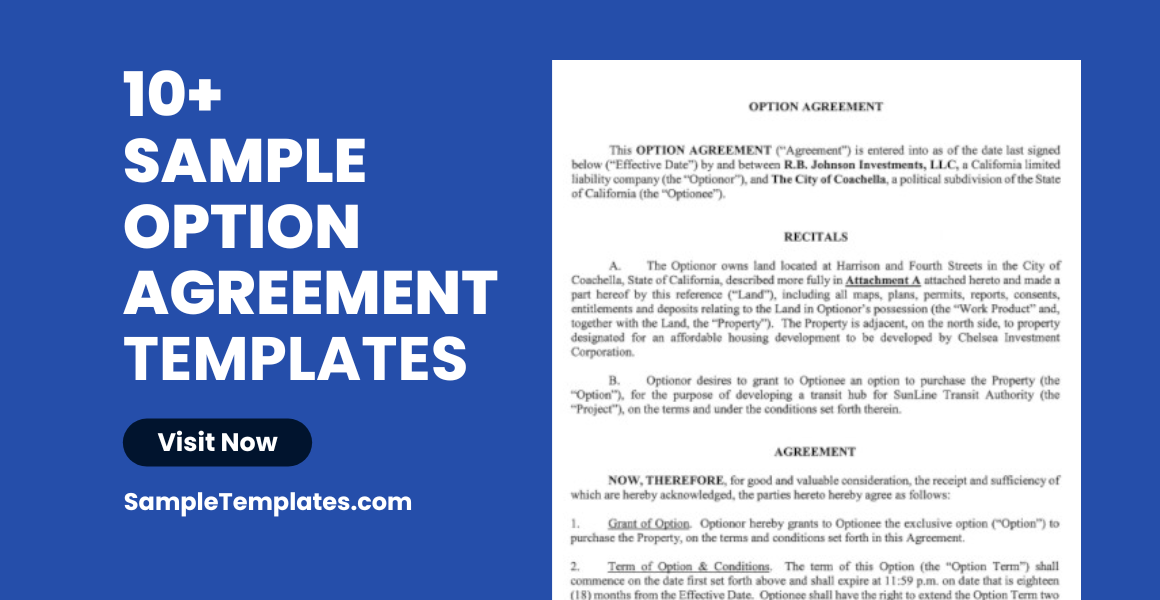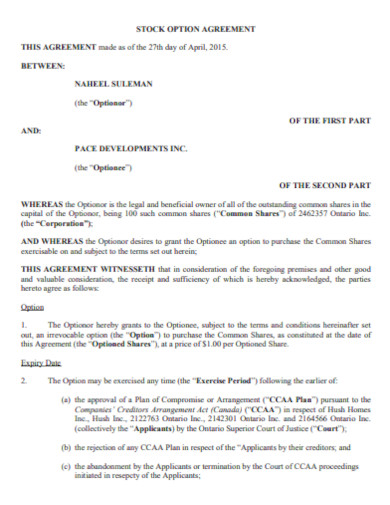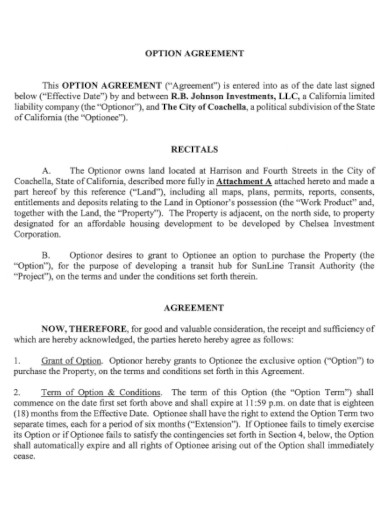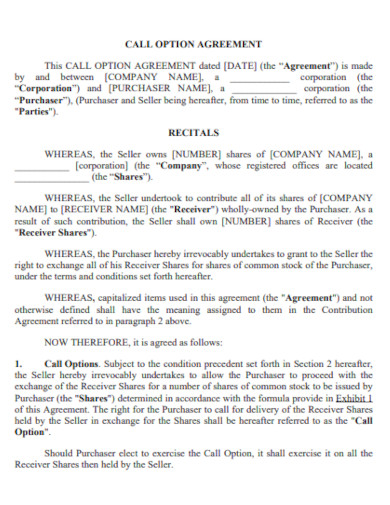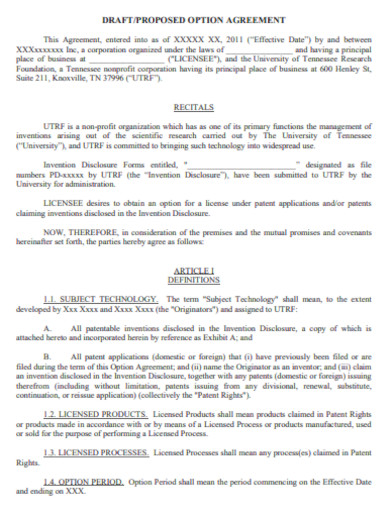An Option Agreement is a pivotal document that outlines the terms and conditions between a seller and a potential buyer, granting the latter the exclusive right, but not the obligation, to purchase or sell assets or shares at a pre-determined price. This legally binding contract secures a fair negotiation window, ensuring both parties’ interests are safeguarded. It’s an essential tool for investors and property owners, providing a strategic pathway for future investment decisions and property transactions.
10+ Option Agreement Samples
1. Sample Land Purchase Option Agreement Template
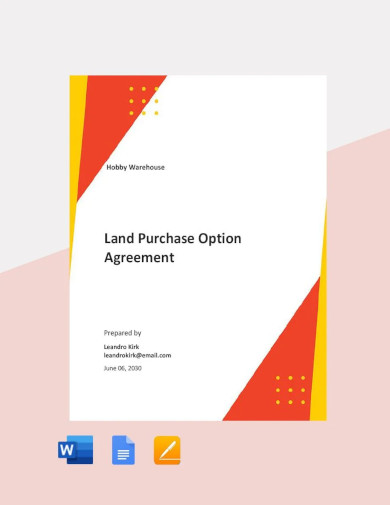
2. Sample Real Estate Purchase Option Agreement Template

3. Sample Real Estate Option Agreement Template
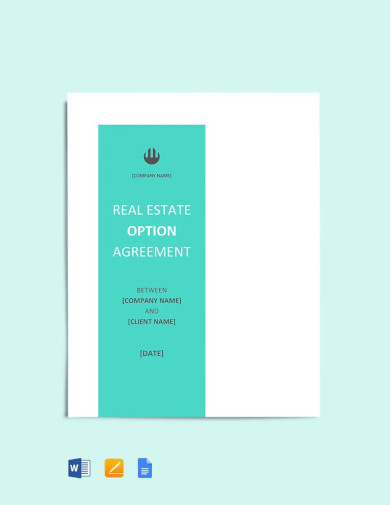
4. Sample Put Option Agreement Template
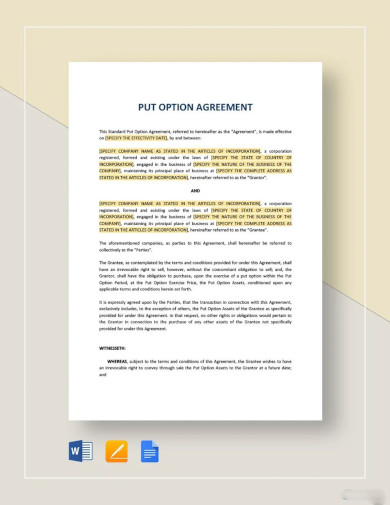
5. Sample Accept Option Extension of Agreement Template

What is an Option Agreement?
An option agreement is a legally binding contract between two entities that gives one party the right, but not the obligation, to perform a transaction with another party at a predetermined price and within a specified time frame. This type of sample agreement is commonly used in financial markets and real estate transactions, but it can also be applied to other situations where the flexibility of a future transaction is beneficial.
Understanding the Basics of an Option Agreement
At its core, an option agreement involves two main parties: the option holder and the option writer. The option holder is the one who acquires the right to execute the transaction, while the option writer is the entity that grants this right. The agreement specifies the details of the transaction, including the asset, the quantity, the price (also known as the strike price), and the expiration date of the option.
An option agreement is used for several strategic reasons:
Flexibility: It allows the buyer to secure the right to purchase an asset without the immediate obligation to buy, providing time to assess the asset’s value or market conditions.
Risk Management: The buyer of an option can limit their potential loss to the option premium, which is particularly useful in volatile markets.
Cost Efficiency: For a relatively small upfront cost (the premium), an option holder can control a potentially large asset, which can be more cost-effective than outright purchase.
Speculation: Investors can speculate on price movements of assets with less capital compared to purchasing the asset outright.
Hedging: Options can protect against price fluctuations in an investor’s portfolio by locking in prices.
Strategic Planning: In real estate or business, options can secure potential deals while the buyer arranges financing or conducts due diligence.
Using an option agreement can be a powerful tactic in both sample investment and business strategies, offering a combination of low-risk potential and strategic flexibility.
Types of Option Agreements
Option agreements come in various forms, each tailored to specific scenarios:
1. Call Option Agreements: These give the holder the right to buy an asset at a set price within a certain timeframe.
2. Put Option Agreements: Conversely, these grant the holder the right to sell an asset at a predetermined price within a designated period.
3. Real Estate Option Agreements: These are used in property deals, allowing a potential buyer to secure the right to purchase a property at a later date.
The Strategic Use of Option Agreements
Option agreements are strategic tools for investors and companies. They can hedge against potential market downturns or secure a price for a future purchase without committing to the transaction upfront. This flexibility is particularly appealing in volatile markets or when future prices are uncertain.
Components of an Option Agreement
A standard option agreement includes several key components:
1. Strike Price: The agreed-upon price at which the asset can be bought or sold.
2. Premium: The cost of acquiring the option, paid by the option holder to the option writer.
3. Expiration Date: The last date on which the option can be exercised.
4. Underlying Asset: The asset which the option concerns, such as shares of stock, commodities, or real estate.
Benefits and Risks of Option Agreements
Option agreements offer the potential for profit with limited risk for the option holder since the most they can lose is the premium paid. For the option writer, the risk can be significant if the market moves unfavorably, but they benefit from the premium received. You can also see more templates like Put Option Agreement Samples.
Examples of Option Agreements in Action
In the stock market, an investor might purchase a call option for shares of a company if they believe the stock price will increase but want to limit potential losses. In real estate, a developer may use an option agreement to secure the right to buy land, giving them time to obtain the necessary permits and funding.
How do you Draft an Option Agreement?
Drafting an option agreement requires careful consideration of the terms and clarity in the document to ensure both parties understand their rights and obligations. Here’s a simplified guide to drafting an option agreement:
Title and Introduction Start with a title that clearly identifies the document as an option agreement. In the introduction, state the date of the agreement and the names and details of the parties involved.
Recitals This section provides context for the agreement format, describing the background and the intentions of the parties.
Definition of Terms Define all the terms used within the agreement for clarity, such as “Option,” “Exercise Price,” “Underlying Asset,” and any other relevant terms.
Grant of Option Clearly state that the option writer is granting the option holder the right, but not the obligation, to purchase the underlying asset.
Option Period Specify the timeframe during which the option can be exercised.
Exercise Price Detail the agreed-upon price at which the option holder can purchase the underlying asset.
Payment Outline the payment terms, including the premium for the option and any other consideration.
Exercise of Option Describe the process by which the option holder can exercise their right to purchase the asset, including any notice requirements.
Representations and Warranties Both parties should make certain assurances about their capacity to enter into the agreement and the status of the underlying asset.
Conditions Precedent If applicable, list any conditions that must be met before the option can be exercised.
No Obligation to Exercise Affirm that the option holder is not required to exercise the option.
Termination Explain how the agreement can be terminated, and what happens if the option is not exercised within the option period.
Governing Law State the governing law that will apply to the agreement.
Signatures Provide spaces for both parties to sign and date the agreement, indicating their acceptance of its terms.
Exhibits or Schedules Attach any additional documents or information that are part of the agreement. You can also see more templates like Option to Buy Agreement Samples.
6. Sample Stock Option Agreement Template
7. Sample Option Agreement Template
8. Sample Call Option Agreement Template
9. Sample Proposed Option Agreement Template
10. Sample Property Option Agreement Template
11. Sample Honors Option Agreement Template
How do you Create Option Agreement?
Creating an option agreement involves several steps to ensure that the contract is legally binding and clearly sample outlines the terms of the deal. Here’s a step-by-step guide:
Step 1: Identify the Parties List the full legal names and contact information of all parties involved in the agreement, typically referred to as the “Optionor” (seller/grantor) and the “Optionee” (buyer/grantee).
Step 2: Describe the Asset Clearly describe the asset or property that is the subject of the option. This could be shares of stock, real estate, or any other asset that can be legally traded.
Step 3: Define the Terms Include a definitions section where key terms used in the agreement are clearly defined.
Step 4: Specify the Option Details
- Grant of Option: State that the Optionor grants the Optionee the exclusive right to purchase the asset.
- Option Period: Define the time frame during which the option can be exercised.
- Exercise Price: Specify the price at which the Optionee can purchase the asset.
- Option Consideration: Outline any consideration (often a fee) that the Optionee must pay for the option.
Step 5: Outline the Exercise Process Detail the process by which the Optionee can exercise their option, including any notice requirements and the method of payment.
Step 6: Address Representations and Warranties Both parties should make certain assurances about their authority to enter into the agreement and the status of the asset.
Step 7: Include Conditions Precedent If there are any conditions that must be satisfied before the option can be exercised, list them here.
Step 8: Discuss the Rights and Obligations Clarify what rights and obligations each party has under the agreement, including any restrictions or covenants.
Step 9: Specify the Governing Law Indicate which state or country’s laws will govern the interpretation and enforcement of the agreement.
Step 10: Termination of the Agreement Explain the circumstances under which the agreement may be terminated, and what happens if the option is not exercised. You can also see more templates like Option to Lease Agreement Samples.
Step 11: Dispute Resolution Outline the process for resolving any disputes that may arise from the agreement, whether through arbitration, mediation, or court proceedings.
Step 12: Signature Block Provide a place for all parties to sign and date the agreement. Ensure that the signatures are witnessed or notarized if required by law.
Step 13: Attach Schedules and Exhibits Attach any additional documents or information that form part of the agreement, such as a legal description of real estate or a certificate of title.
Step 14: Review and Consult Before finalizing the agreement, have it reviewed by a lawyer to ensure that it complies with all legal requirements and adequately protects your interests. You can also see more templates like Real Estate Purchase Option Agreement Samples.
What is a Call Option Agreement?
A call option agreement is a sample contract that gives the buyer the right, but not the obligation, to buy a specific quantity of an asset, such as stocks or real estate, at a set price within a certain time period. The seller of the call option agrees to sell the asset at that price if the buyer chooses to exercise the option.
How Long is the Option Agreement?
The length of an option agreement, known as the option period, is negotiated between the buyer and seller and can vary widely depending on the asset in question and the needs of the parties. It could be as short as a few days or as long as several years. Commonly, option periods may last from three months to a year in financial markets, while real estate option agreements might have longer periods to allow for due diligence and financing arrangements. The specific duration should be clearly stated in the agreement to avoid any confusion.
What is a Cross-Option Agreement?
A cross-option agreement, often used in business partnerships or among shareholders, is a mutual arrangement that ensures the remaining partners or shareholders have the right to buy, and the departing partner or shareholder’s estate has the right to sell, the interest of a deceased or exiting partner or shareholder. This type of agreement is typically linked with life insurance policies to provide the necessary funds for the transaction. It’s designed to simplify the transfer of ownership and maintain business continuity.
In Conclusion, option agreements are versatile instruments that can be tailored to fit a variety of transactional needs. They provide a way to manage risk, speculate on future price movements, and offer strategic flexibility in both financial and analysis of real estate markets. Understanding the intricacies of these agreements is crucial for anyone looking to use them effectively in their investment or business strategies.
Related Posts
FREE 10+ Mentoring Agreement Samples In MS Word | Apple Pages | PDF
FREE 10+ Partner Agreement Samples In MS Word | Google Docs | Apple Pages | PDF
FREE 10+ Individual Agreement Samples In MS Word | Google Docs | Apple Pages | PDF
FREE 10+ Strategic Agreement Samples In MS Word | Google Docs | Apple Pages | PDF
FREE 10+ Equity Agreement Samples In MS Word | Google Docs | Apple Pages | PDF
FREE 10+ Producer Agreement Samples in MS Word | Apple Pages | PDF
FREE 10+ Grant Agreement Samples In MS Word | Apple Pages | PDF
FREE 8+ Meeting Agreement Samples in MS Word | Google Docs | Apple Pages | PDF
FREE 10+ Community Agreement Samples In MS Word | Google Docs | PDF
FREE 8+ Real Estate Option Agreement Samples in MS Word | PDF
FREE 10+ Call Option Agreement Samples In MS Word | PDF
FREE 10+ Advertising Agreement Samples In MS Word | Google Docs | Apple Pages | PDF
FREE 10+ Car Agreement Samples In MS Word | Google Docs | Apple Pages | PDF
FREE 10+ Horse Agreement Samples In MS Word | Apple Pages | PDF
FREE 9+ Project Management Agreement Samples in DOC | PDF
